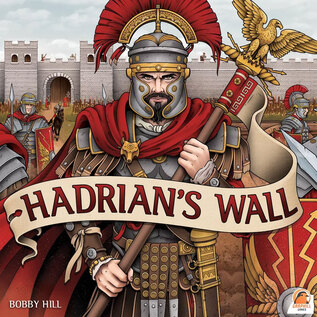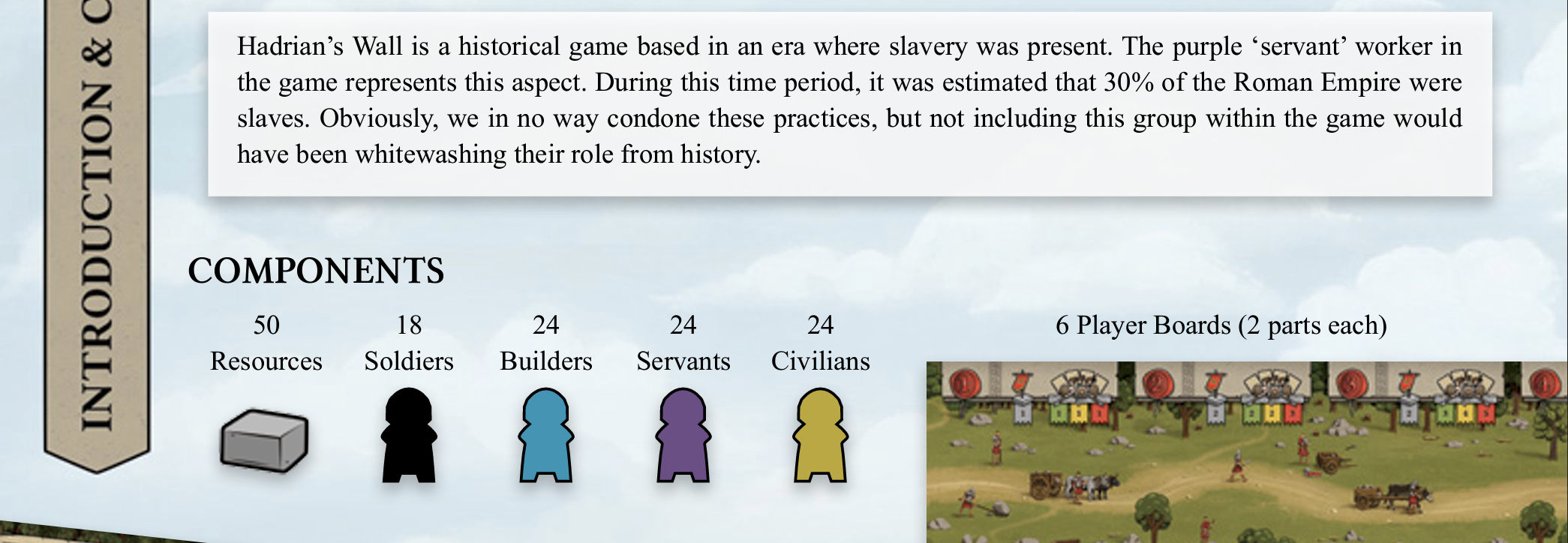 Hadrian's Wall was one of my favorite board games of 2022, even though it was actually published in 2021. Although the game is not "historical" in any true sense, playing it did make me want to do a deep dive. Since then, I've taken more of an interest than anticipated—to the point where I would really like to go and hike that wall! Although I am certainly knowledgable about the Roman Empire and its ways, I am by no means an expert on Hadrian's Wall specifically. What I have been learning is... fascinating. I began my studies with a few questions in mind that were related to how the board game Hadrian's Wall presents the wall and its history. I wanted to know what the border security situation actually was, I wanted to know about the settlements that sprung up along the wall, and I wanted to know who actually did the physical labor that was necessary to make it happen. I did not get conclusive answers on any front, but I did learn a lot, which frankly is par for the course when we are asking historical questions whose answers are limited by scant evidence. I didn't expect my next deep dive to be about slavery. I actually want to write some think pieces about barbarians. But the issue has found its way to me yet again, this time spurred on by an aside from the Hadrian's Wall rulebook: So, according to the rulebook, we are dealing with an "era where slavery was present." This is absolutely accurate. What I initially took issue with was the fact that, after this bleak little historical note, we all go on to refer to these meeples as "Servants" for the rest of the game as if that actually makes this any better. (It doesn't.) What I did not expect to find, however, was a bunch of waffling from ancient historians about whether slaves were involved in the actual work of building Hadrian's Wall. There is no question whatsoever that slaves were present at the wall, especially in the settlements that cropped up alongside it. But did they build the wall? Or, as the game version of Hadrian's Wall suggests, did they quarry the stone? My current answer is that there is a good chance, with no way to conclusively prove it. But it actually took me a lot of effort to get there, which is probably the most interesting aspect of this journey. Early on in my reading process, I decided to do what anyone would do, and asked Google some questions. One of my early hits was the official Vindolanda tourist website, which actually has a question about slavery in the FAQ. The site's official copy states: "No, the Wall was built by the skilled Roman legionary masons, with thousands of auxiliary soldiers providing the labour and bringing the vital building supplies to the construction areas." There is at least some truth to this—the Roman army did complete public works projects when soldiers were not actively fighting. At the same time, methought the Imperialists didst protest too much. So I kept digging. I started with some fairly obvious books, including Adrian Goldsworthy's Hadrian's Wall. Although Goldsworthy doesn't hit the issue head on, he does mention living spaces for slaves who assisted cavalry officers, and notes that "slaves, including many owned by the army itself," would have lived along the wall and performed noncombatant functions (Goldsworthy 77, 82). When discussing general army activities, Goldsworthy writes, "Some of these tasks were performed by army slaves or personal slaves owned by some soldiers, especially cavalrymen, but much was done by the legionaries and auxiliaries themselves" (ibid., 92). So, while Goldsworthy is not willing to straight up say that enslaved people were put to work to construct the wall itself, he feels comfortable concluding that they were present in some fashion. Nick Hodgson, author of Hadrian's Wall: Archaeology at the Limit of Rome's Empire, is also (too?) delicate in his handling of the situation. As he puts it, "It is possible that impressed or prisoner labor was used, perhaps in the laborious tasks of digging the Wall ditch and Vallum or transporting materials, but given the degree of precision required and the difficulties of supervision that this would entail, it is unlikely. Legionaries were proud of their ability to carry out such works at speed, and they would not have found them below their dignity" (Hodgson, 89). He does, however, acknowledge the presence of slaves with the army, and at other points mentions that we cannot rely on time estimates for construction that do not take forced labor into account (ibid., 117). Hodgson's comments absolutely fascinated me, for one reason in particular—we know for a fact that slave labor did not necessarily mean unskilled labor. Being an enslaved person in ancient Rome did not imply that a person was uneducated or not a specialist in some way. Slaves did a lot more than manual labor—they taught Greek to Roman children, they performed advanced accounting, and could even act as doctors. There is basically no job in the Roman world that a slave could not perform. Hodgson is perhaps a little too protective of the legionaries' pride. The Roman Emperors themselves were often criticized for elevating their freedmen to powerful positions within the Empire. As a result of further digging, I found two more sets of information. I first stumbled across Morris Silver's article, "Public Slaves in the Roman Army: An Exploratory Study." While the article contained many interesting details, what was more interesting is how little we actually know. It's pretty clear that the army owned slaves, and that they could hold several different jobs, but the exact extent of their involvement is unknown. The second was that according to The Construction of Hadrian's Wall, written by a stonemason who then studied the classics, the actual building work at Hadrian's Wall is functional—but not indicative of the proud and skillful work to which Hodgson alludes. According to Hill, with more training the wall could have been better, but "this was regarded as unimportant, hence the ill-worked, half-finished stones which are typical of milecastle and fort gateways on the Wall. Perhaps even more relevant than the level of training is the obvious lack of care about the appearance of the finished work" (Hill, 128). Although Hill does not rule out the possibility of forced labor at the wall, he does not commit to saying so one way or the other, citing lack of evidence. And in the end that may be what is most interesting about all of my inquiries into Hadrian's Wall. The lack of evidence is astounding given how extensive the wall itself is. We don't have good, detailed army records spanning the relevant time period. We do have inscriptions. We have some writings from Vindolanda, but those largely date to before the construction of the wall (Hodgson, 11). It's not even clear that the wall was built entirely for security purposes—the evidence of alleged barbarian attacks is scant. In fact, the Romans felt comfortable pushing further north immediately after Hadrian's lifetime. The actual border of the Roman Empire in Britain became the Antonine Wall under Hadrian's successor, Antoninus Pius, before receding back to Hadrian's Wall. That, however, is probably the topic of a future blog post. I did, after all, say that I wanted to write about barbarians. ;) So what was the point of all my ramblings? In the context of game talk, despite my dislike of the term "servant," I want to give Hadrian's Wall props for reading the labor situation correctly. And, in some ways, more bluntly than the professionals. We can't necessarily prove that forced labor contributed to the construction of Hadrian's Wall, but everything we know about the Roman Empire and its workings—including its practice of keeping publicly-owned slaves—indicates that we should assume its presence. I am forever fascinated by the clear instinct to smooth over this reality, even among historians. Vindolanda's tourist materials pronounce the wall "clean" of slave labor. Hodgson can't deny the likelihood of slave labor in the army at the wall, but he'd like to think that the legionaries were too proud of their own skills to use it. Goldsworthy acknowledges the presence of slave labor along the wall, but gently avoids the critical pulse point. Why do we collectively do this? As with everything about Hadrian's Wall, there is no single definitive answer. But I think this tendency speaks to the deep wounds that the practice of slavery has inflicted on our own society, and our collective discomfort about that reality. This discomfort has become so intense in the United States that Florida is blocking AP African American studies under the guise that it is "CRT." When doing history, there are always two narratives--our version of "what happened," and the story that we are telling about ourselves by doing history. Our desire to minimize, and even to erase, will define us in the eyes of future historians who look back at us and how we talk about the past. References:
Adrian Goldsworthy, Hadrian's Wall, Basic Books, New York, 2018. Peter Hill, The Construction of Hadrian's Wall, The History Press, Brimscombe, 2010. Nick Hodgson, Hadrian's Wall: Archaeology at the Limit of Rome's Empire, Robert Hale, Ramsbury, 2017. Morris Silver, "Public Slaves in the Roman Army: An Exploratory Study," Ancient Society 46, 2016, 203-240.
2 Comments
Jean-Luc Szach
2/6/2023 11:53:33 am
Liz, thank you again for a thought provoking and well-researched blog post. I look forward to these! I agree with your final assessment.
Reply
Christian van Someren
2/7/2023 11:28:02 am
Fascinating analysis. Hadrian's Wall was one of my favourite discoveries last year, but I ha just assumed they were whitewasing history (as eurogames tend to do). Interesting that it is much more complex than that.
Reply
Your comment will be posted after it is approved.
Leave a Reply. |
AuthorMy name is Liz Davidson, and I play solo board games. A lot of solo board games... Archives
August 2021
Categories
All
|

 RSS Feed
RSS Feed